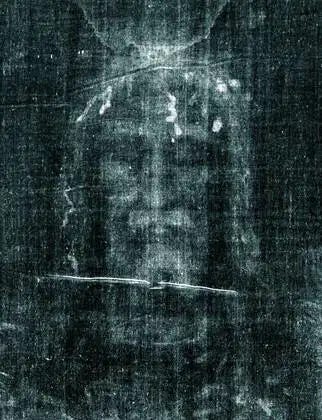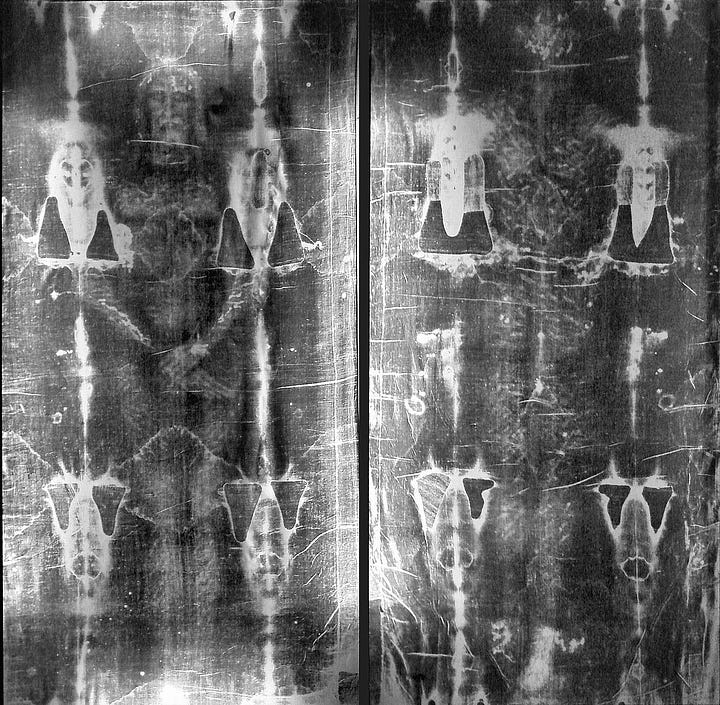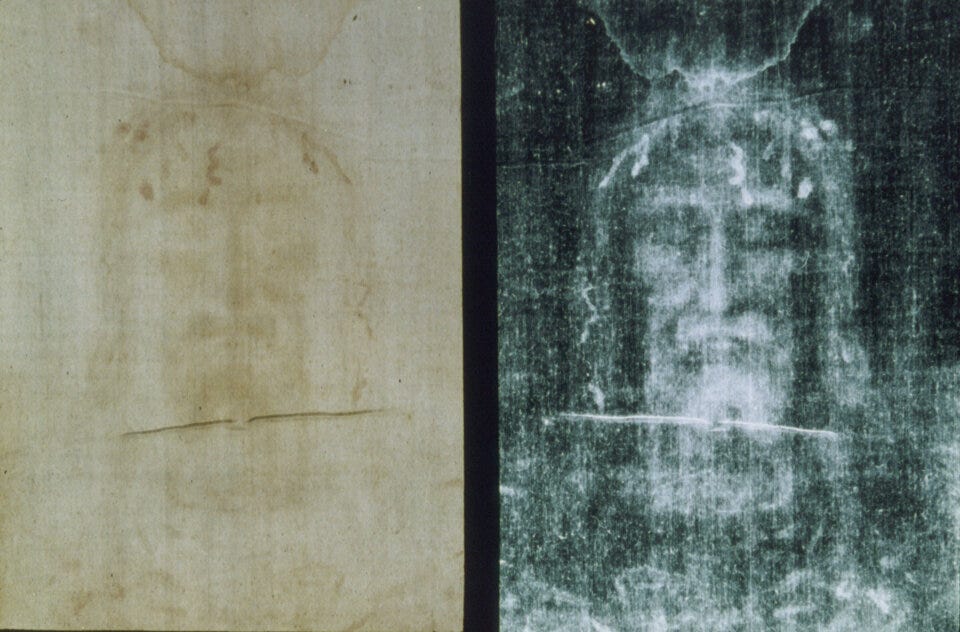The Shroud of Turin: Hoax, Miracle, or Proof of the Resurrection?
Science Can’t Replicate It. History Can’t Explain It. Is the Shroud of Turin the Burial Cloth of Jesus or the Greatest Hoax Ever?
The Unfading Image: Introduction to the Shroud of Turin
It looks like a faded ghost—an image of a man, crucified, with blood at his wrists, feet, and side. He lies there, eyes closed and arms folded. To the naked eye, it's faint but in 1898, an Italian photographer flipped the negative and saw something that shocked the world: the image was clearer, sharper, almost photographic. A photo-negative of a man who may have lived 2,000 years ago.
The Shroud of Turin has been called a relic, a fraud, a miracle, and without dispute a mystery. For over a century, it has resisted final judgment. Is it the genuine burial cloth of Jesus Christ, miraculously bearing his image? Or is it the most impressive forgery ever created—so advanced that even modern science can’t quite duplicate it?
I lean toward authenticity but even if it’s not, the Shroud remains the greatest fraud in history—an artifact so sophisticated that 21st-century researchers still scratch their heads.
The Case for the Hoax: Radiocarbon Dating and Medieval Relic Culture
Let’s start with debunking. In 1988, radiocarbon dating tests concluded that the Shroud of Turin originated between 1260 and 1390 AD. Conveniently medieval. Around the same time, a French bishop, Pierre d’Arcis, had claimed in a letter to the Pope that the Shroud was painted by an artist. This matches the era when Europe was saturated in relics—splinters of the “true cross,” feathers from the Archangel Gabriel, and enough saint bones to fill a football stadium.
Some skeptics propose the image was made using medieval techniques like bas-relief (think the surface of a coin and the depth on it), painting, or early photographic tricks. It makes sense—until you try to replicate it.
Pollen and Weave Evidence Point to Middle Eastern Origins
Enter the messy details. Swiss criminologist Max Frei conducted a pollen analysis on the Shroud in the 1970s. He found pollen native to Jerusalem, Edessa (modern-day Urfa in Turkey), and Constantinople—suggesting the cloth traveled through the ancient Christian world long before Europe’s medieval relic craze.
Then there’s the weave. The linen is a 3:1 herringbone twill—a style known in 1st-century Syria, but extremely rare in medieval Europe. Nothing about the fabric itself screams 14th century.
And what about paint? STURP (Shroud of Turin Research Project) scientists used chemical, microscopic, and spectral analysis to search the Shroud for pigments and found none. No brush strokes, no dye, and no applied substance of any kind. The image isn’t “on” the cloth; it’s somehow in it.
Re-dating the Shroud: Did Scientists Test a Repaired Area?
Critics of the 1988 carbon dating argue that the tested sample came from a corner of the cloth that had been repaired after fire damage in the 1500s. Textile chemist Raymond Rogers confirmed that the corner showed signs of cotton interweaving and chemical treatments not found in the rest of the linen.
Further studies using alternate dating methods, including infrared spectroscopy and vanillin loss, suggest a much older date—possibly between 300 BC and 300 AD. If true, that lands us squarely in the time of Christ.
The Negative, the 3D, and the X-Ray Image of Christ
Here's where things get weirder.
In 1898, Secondo Pia took the first photographs of the Shroud. His negatives revealed a positive image—meaning the Shroud itself behaves like a photo negative. No one expected that. And that was just the beginning.
Modern imaging tools have revealed something bizarre: the Shroud’s image actually holds 3D information. The lighter and darker parts of the image match how close different parts of the body were to the cloth—almost like a map of depth or elevation. NASA scientists looked at it and said no known artistic method, ancient or modern, could create something like this by hand.
But the real kicker? The Shroud has X-ray-like qualities. You can see teeth through the skin. The bones of the hand appear visible and with anatomically accurate wrist positioning (unlike most medieval art, which places the nails in the palms). The eyes appear to have small round objects over them, likely coins which were a 1st-century Jewish burial custom.


And there’s the physical trauma. The man on the Shroud shows signs of horrific suffering:
Over 100 scourge marks, consistent with a Roman flagrum (a whip with metal or bone tips).
Bloodstains across the scalp and forehead in a circle pattern—likely from a crown of thorns.
Abrasions on the knees and nose, consistent with multiple face-first falls.
A large wound in the side, consistent with a spear thrust.
Blood flows at the wrists and feet, consistent with crucifixion via nails.
No broken legs, matching the Gospel account of Jesus’ death (John 19:33).
How would a medieval forger depict details beneath the skin? Why would they even think to try?
Some researchers have proposed that the image was caused by a burst of radiant energy—maybe even from the Resurrection itself. Outlandish? I can see why one would think that but no one has created a convincing alternative.
Why the Shroud of Turin Can't Be Replicated
Scientists and skeptics have thrown everything at trying to recreate the Shroud. They've tried acid, heated metal shapes, powdered pigments, even high-tech UV lasers. Some of the copies look similar at first glance—but none of them match all the Shroud’s unique traits. The image on the real Shroud sits only on the very top fibers of the cloth, has a photo-negative quality, contains 3D information, and shows no signs of paint, brushstrokes, or a clear direction of how it was made.
In 2010, scientists at Italy’s National Agency for New Technologies used a high-energy UV laser to create a faint image that mimicked some Shroud properties but it required technology not invented until the 21st century—certainly not available to a medieval artisan.
Is the Shroud of Turin the Burial Cloth of Jesus?
So what is it? An inexplicable accident? A relic of the Resurrection? The world’s most advanced hoax?
I lean toward authenticity. Too many independent lines of evidence—pollen, textile, anatomy, radiative characteristics— all converge on the idea that this cloth may indeed have wrapped the body of Jesus of Nazareth.
And the theory I find most compelling is this: the image may have been created by a burst of radiant energy at the moment of the Resurrection. It would explain the superficial nature of the image, the photo-negativity, the 3D information, and the X-ray-like qualities. It’s speculative, yes—but not unthinkable.
And curiously, Scripture has always described God in terms that resonate with intense energy and light.
In Matthew 17:2, during the Transfiguration, “His face shone like the sun, and his clothes became as white as the light.”
At the Resurrection, Matthew 28:2–3 describes the angel with “an appearance like lightning, and clothes white as snow.”
Acts 9:3–4 recounts Paul’s encounter with the risen Christ: “a light from heaven flashed around him,” so bright that it blinded him.
Even the Old Testament describes God as dwelling in unapproachable brightness—see Exodus 34:29 and Daniel 10:6.
If the Resurrection was the intersection of heaven and earth, spirit and matter, then maybe—just maybe—this light wasn’t metaphorical. Maybe it was physical.
But even if it’s a fake, it’s not a simple deception. It’s a masterpiece of fraud so advanced, so impossibly clever that even our most sophisticated tools can’t reproduce it.
Either way, the Shroud should not be a litmus test for faith. Christianity rests not on cloth, but on a cross and an empty tomb.
Conclusion: The Image That Endures
The Shroud of Turin is either a silent witness to the resurrection or the most mysterious fraud in human history. Science doesn’t yet have the tools to say which. What we do know is this: for an image that shouldn’t exist, it has left an unforgettable mark on both science and faith.
If it is a hoax, it’s one that outperformed its own era by centuries.
And if it’s not?
Then perhaps we are staring at a lightprint of eternity.
References
Damon, P.E. et al. Radiocarbon Dating of the Shroud of Turin. Nature, Vol. 337, 1989. https://doi.org/10.1038/337611a0
Rogers, R. N. Studies on the Radiocarbon Sample from the Shroud of Turin. Thermochimica Acta, Vol. 425, 2005. https://doi.org/10.1016/j.tca.2004.09.029
Schwalbe, L. A., and Rogers, R. N. Physics and Chemistry of the Shroud of Turin: A Summary of the 1978 Investigation. Analytica Chimica Acta, Vol. 135, 1982.
Frei, M. The Presence of Palestinian and Anatolian Pollen Grains in the Shroud of Turin. Shroud Spectrum International, No. 3, 1982.
Jumper, E. J., Jackson, J. P., et al. A Comprehensive Examination of the Various Image Characteristics of the Shroud of Turin. IEEE Proceedings, 1984.
Biblical References: Matthew 17:2; Matthew 28:2–3; Acts 9:3–4; Exodus 34:29–35; Daniel 10:6.











